Thanks to ININ Games for the review code
Title: TAITO MILESTONES 2
System: Nintendo Switch
Price: $39.99
Release Date: 08/31/2023
Prelude
Last year we reviewed a simple compilation of ten Arcade Archives Taito games… And now ININ’s back with another batch of ten ACA games. Let’s take a look and see what they have on offer in this second volume!
Presentation
As before, the game starts on a very barebones game select menu, with all the games being singular versions of their respective arcade archives releases, with older games like The Legend of Kage and Kiki Kaikai even using the older UI style from that era of ACA. No bonuses or any sort of extras are included, unfortunately, outside of a nice game select song on the main menu. Luckily all games here emulate as they should with no weird downgrade compared to ACA, unlike the Qix issue from the last set.
Gameplay
You know the drill: no bonuses, just games, so let’s go into each of them and cut to the chase!
BEN BERO BEH: This is a very strange early Taito game, where the main objective is to climb down a burning building and put out endless fires while trying to rescue a captive girl at the bottom floor. Not much else to it, as the stages progressively get tougher, the obstacles quickly become rather annoying, and outside of trying to best your score this is a pretty thin game, and the weakest of the set. Luckily, that’s a good thing, since this isn’t really a bad game at all, just strange and very repetitive.

THE LEGEND OF KAGE: An action game with a simple gameplay loop. You start out in the forest and have to defeat all the ninjas blocking your way, with both your throwing stars and melee sword slashes to take out the variety of ninjas that’ll try and ambush you. Then, you move into a waterway where you have to defeat a certain number of bad guys before you progress to the outer wall of the castle, where you must climb to the top and infiltrate it. You then do another action stage akin to the first, where you scale some stairs, fight ninjas along the way, and save the princess, only for it to repeat all over again in another season.
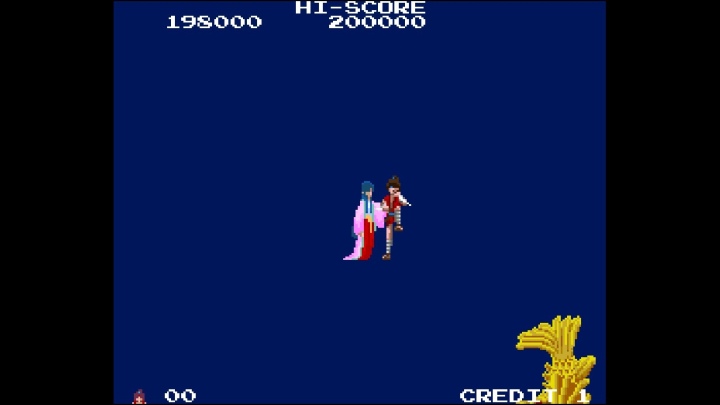
Despite the simple loop, Kage can be a bit brutal at points, with the first and last stages having a lot of enemies thrown at you, and any slight brush against a hazard will cause the ninja to fall to his death. Still, I found myself having tons of fun with this gem of a game, since even the rougher stages have a sense of trial and error to them, and before long, you’ll be able to get the hang of blocking enemy projectiles and taking out the bulkier enemies before they get to you, making the seasons fly by as you shoot for the leaderboards.
For a scorechaser, Legend of Kage isn’t too in-depth, but you’ll at least have fun trying to see how long you can survive, and really the only sort of gripe I have with the version in Milestones 2 is that you only get one version of the game; the earlier, non-FM sounding one, rather than being able to have both audio variants available like in the standalone release. Otherwise, this is an excellent port of a very fun early Taito hit.
KIKI KAIKAI: Pocky And Rocky Reshrined was a great game, and that title’s lineage all started with this Arcade gem. You take control of a shrine priest, and set out on a quest to rescue the spirits that have been taken captive by evil forces. You have talismans to throw at enemies, and a melee wand weapon to swat away small foes or discover secrets, including helpful powerups buried within certain objects like lanterns.
Kiki Kaikai is pretty fun, and as a game for 1CC attempts, this game definitely fits the bill as one, since later stages get incredibly hard due to one hit deaths and increasing waves of enemies, along with tougher bosses who aren’t afraid to rush after you. However, those who are more used to the co-op focused sequels with crazier level designs and more techniques might be a bit disappointed by the simplicity present in this game, but honestly, I find Kiki Kaikai to be an excellent starting point, and as a scorechaser from the time, it serves that purpose really darn well, even if the music can be a little obnoxious. Just don’t go in expecting a co-op experience and focus on playing for points, and you’ll find this is a damn fine game.
The New Zealand Story: A very popular game in PAL regions due to the home computer scene, The New Zealand Story is an action platformer where you have to guide a Kiwi on an epic quest to save his missing family, scattered around parts of the titular region. It controls well with tight movement and a simple attack/jump scheme, with the best part of New Zealand Story coming from the bountiful amount of secrets this game holds.
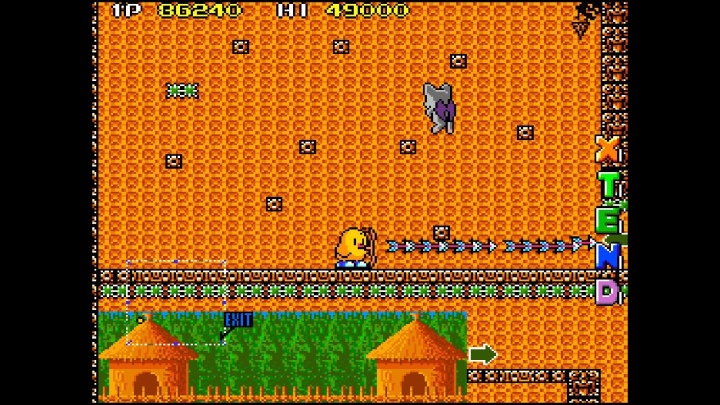
One moment you’ll be wandering around, shooting enemies or stealing their balloons to reach other parts of the stage, and then you’ll find a secret door! These doors offer lots of goodies, such as the EXTEND letter combination, lots of items for bonus points, or even warps to future stages or other parts of the same level, and there’s quite a lot of these fun secrets to poke around and discover.
Even just playing the game in a vanilla fashion is really damn fun, and as levels get trickier with lots of spikes and other obstacles thrown at you, I never really found New Zealand Story too hair-pulling, since even if some sections might take several tries to finally conquer, the fun factor was still present from start to finish of all my 1CC attempts, and while the later worlds definitely don’t pull any punches, even these frustrating moments get overshadowed by just how much fun it is to scorechase or hunt down secrets. Definitely the best game in the entire collection, and the most fun to replay again and again.
DARIUS II: Part of Taito’s famous Darius series, Darius II and other regional variants have been featured before as part of M2’s excellent Cosmic Collection compilations, but the version present in Milestones still manages to be one that missed those sets, for this is the rare three-screen version, which retains the original Darius’ ultra-wide display, and crams a whole new, awesome set of stages into it.

Usually, Darius II/Sagaia is a two screen game, and while that definitely works better for visibility purposes, I didn’t find the three screen aspect of II here all that distracting, much to my surprise, and it adds some extra visibility to the shooting action here. You still control one of two Silver Hawk ships as you set out on a branching adventure to take out a variety of evil fish-themed foes, and just like the first game you can upgrade your main weapon, bombs, or your protective shield to take on the tougher challenges ahead. With plenty of alternate routes and scoring bonuses, this is an immensely fun game, and the Sagaia version just so happens to be my personal favorite Darius in the whole franchise.
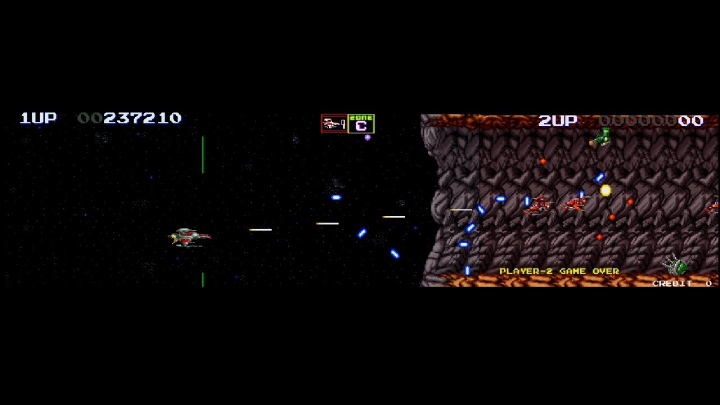
Unfortunately, only the three screen version of Darius II is present on Milestones 2, with no Sagaia in sight, but that doesn’t stop Darius II from being an excellent game, even if the visibility takes a bit of a hit as a result (Handheld mode can seem ant-sized on a Lite!). Still, like with Ninja Warriors, there are some neat display options you can toggle for those multi-screens, including a few color/LCD options, which I appreciate as a way to help make the game look a bit better.
Liquid Kids: Another action platformer, only this time you take control of a Platypus fighting back against flaming enemies with the power of water. You have balls of water that you can throw on enemies, and when burst, they unleash a stream that can push enemies or other objects around, making for pretty fun instances of lining up foes to sweep them away in a big wave, for great scoring potential. Think the sort of water wave shenanigans you can get up to in a Bubble Bobble game, and you have the main gimmick of Liquid Kids down pat.
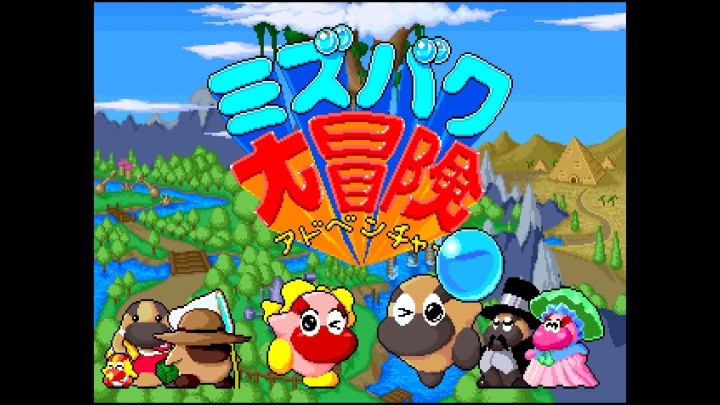
Of course, you don’t just have the tiny water balls, since you can even charge them up to increase their size, making them more useful if you happen to be surrounded by enemies, or fighting a boss. Add in the variety of obstacles such as water wheels that benefit from the water flowing a certain way, and you have a creative, charming platformer that is neck and neck with New Zealand Story for being my favorite of the set. Great scoring potential, too!
Gun Frontier: A vertical shooter where everything is gun-themed! You and a co-op partner can take flight, shooting back against waves of foes as you take them down and progress throughout the several stages on offer. Typical shot/bomb setup, though interestingly enough the game’s rank will change if you use a higher rapid fire setting, meaning that in a way you can control the game’s difficulty on the fly, with enemies getting more aggressive the faster you shoot.
You also don’t just collect standalone bombs like most shooters, but pieces dropped by enemies, and the more pieces you stockpile, the bigger your bomb blast will be, with weaker ones barely being able to deal damage around you, and the biggest blasts having the capability of distorting your screen. Oddly reminiscent of future games like Battle Garegga with these aspects, and yep, playing for score or 1CC attempts will lead to rather brutal runs. Still a decent time, although I’m really not a big fan of the sudden death fight at the end of the game, which leads to an instant game over if you fail it, regardless of the amount of credits you have.
Solitary Fighter: One of two fighting games in this set, and this one is a sequel to Taito’s Violence Fight, a pre SFII fighter where you mainly fight foes in 8 way arenas, using button combinations to pull off special moves. There are a couple of characters to choose from, and all have their own unique moves, but the main objective is still to win the best 2 out of 3, with more points being awarded depending on if you manage to clear the fight without losing a round.
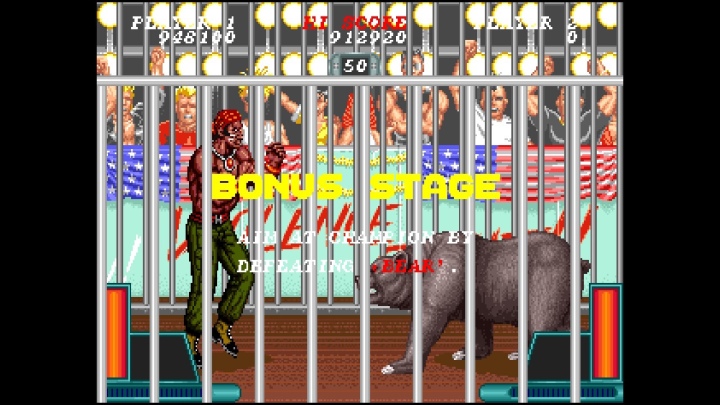
Decent as a scorechaser due to the end of match bonuses and bonus rounds, very fun as a 1V1 game with a local friend, and pretty frustrating after a certain point when fighting the CPU, since certain stages will be on a strictly flat plane, which can make some characters’ special moves a lot weaker and harder to hit with. The music is at least very catchy, and the game also isn’t shy about displaying a lot of flashy onomatopoeia whenever someone gets struck, which oddly reminds me of Kakuranger, of all things.
Metal Black: The final shooter of the set, and the game that’s a sequel of sorts to Gun Frontier. While that title was a vertical game, Metal Black goes horizontal, taking you across several stages as the Black Fly ship, with only one weapon usable throughout the entire journey. You don’t even get bombs here, but what you do get are molecules dropped from foes that power up your main beam, with it upgrading level by level depending on how many molecules you gather, until it gets maxed out and has the capability to either be a gargantuan beam blast, or a wild, scattering laser.
The beam is definitely the focus of Metal Black, and it’ll even come in handy during the weird bosses present here, as Metal Black gets rather bizarre. Super trippy backgrounds and increasingly nonsensical stages, culminating in a final boss that cycles through what appears to be periods of time and capping off with an ending you just gotta see to believe. Still, that doesn’t mean Metal Black isn’t fun, as it does manage to be a fun shooter for the most part. Your beams can counter the beams of the bosses and lead to some pretty intense fights, and the molecules are plentiful, meaning you always have an opportunity to pull out the beam when you need to.
Unfortunately, I did find the weakest aspect of Metal Black to be the enemy placement, as sometimes if you don’t memorize or know where enemies are coming from, you might just have a foe randomly show up from behind and destroy you, and later stages can get absurd with all of the gotcha moments, making 1CCing this game way tougher than it needs to be. Still, Metal Black is an incredibly charming shooter with great presentation values, even if in terms of balance and fun factor, it manages to be the weakest shooter on the set.
Dino Rex: Ending the chronological list, Dino Rex is one insane game. Meant to be another shooter from the same minds behind Gun Frontier and Metal Black, this got genre shifted into a fighter about dinosaurs due to the fighting game craze of the time, and to say that Dino Rex is unbalanced would be very generous. You have a few moves at your disposal, and each dino can pull off their special moves through the same button commands, so you don’t need to memorize a bunch of move lists, which sounds like a good thing, until you realize that the attacking potential of each dino is drastically different from one another to the point some are utterly useless, while some are way too overpowered. Once you find a dino’s best move, you’ll pretty much be using that until the AI fights back hard enough to make you extinct.
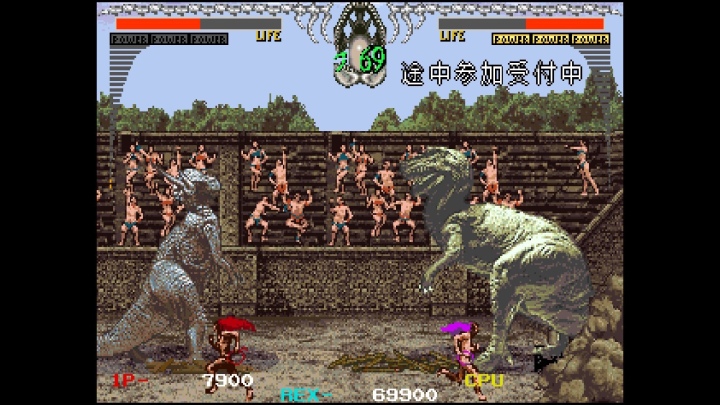
Funnily enough, you even get bonus stages where your Dino is suddenly thrown into a modern day civilization and has to destroy a town. This sort of nonsensical backdrop shifting was one aspect that made Metal Black so charming, and at the very least I was pleasantly surprised to see the same sort of wild creativity put into this fighter, even if the core fighting isn’t too much fun when playing solo. At the very least, the chaotic balancing makes this an excellent local multiplayer game, with the sort of laughs you’ll get out of messing with your friends absolutely worth learning this quirky game’s mechanics.
Conclusion
Taito Milestones‘ biggest problem was a very basic interface with very basic games that were tough for most folks to get into, especially fans of Taito’s later Arcade stuff, and while Milestones 2 still carries on the same basic interface and simplistic wrapper, the game selection here is a lot better and is from that later era. You get the full trilogy of weird Gun Frontier games, the excellent New Zealand Story and Liquid Kids platform titles, the fun loop of Legend of Kage, the first ever reissue of three screen Darius II, and some other oddities that are decent time wasters.
Really, there isn’t a bad game in the bunch, and the ACA style means all of them are well emulated, with only the alternate regional ROMs and the Caravan/high score modes from the standalone ACA releases being absent from the Milestones versions here. If you like a game from this set and want to play it, then you’ll enjoy how it’s emulated here, even if there’s not a thing akin to a bonus feature here. Still, I found that New Zealand Story, Liquid Kids, Darius II and Legend of Kage are easily the best of this batch, and Taito Milestones 2 is well worth picking up for newcomer scorechasers and veterans alike.
I give TAITO MILESTONES 2 a 7 out of 10.

